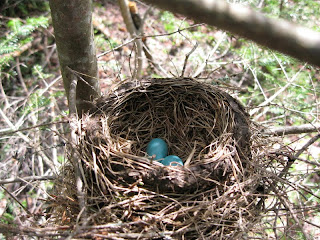Piping plovers are little shorebirds that are among the few that actually breed and nest here on Cape Cod. Although we have many shorebirds at area beaches and marshes in the spring and fall most are just moving through and stop to feed here and rest before heading farther north where they breed. If you live anywhere near a beach on the east coast you are probably well aware that piping plovers are endangered, mostly because they happen to like the same sandy beaches we humans like. As you can see in these photos piping plovers are very well camouflaged and many people probably walk right by them on the beach without seeing them.
If you live anywhere near a beach on the east coast you are probably well aware that piping plovers are endangered, mostly because they happen to like the same sandy beaches we humans like. As you can see in these photos piping plovers are very well camouflaged and many people probably walk right by them on the beach without seeing them.
 Their good camouflage protects them from predators but it also causes problems for them and their little ones. Their nests get stepped on, the little ones get separated from the parents and animals, including dogs, chase them or scare them. Many beach dog walkers insist that their dog would never harm a bird and that may be true. What they don’t realize is that the very presence of a dog can scare these birds in a way that may result in nest abandonment and even death. A dog, after all, resembles natural predators such as foxes and coyotes which these birds are programmed to avoid and fear.
Their good camouflage protects them from predators but it also causes problems for them and their little ones. Their nests get stepped on, the little ones get separated from the parents and animals, including dogs, chase them or scare them. Many beach dog walkers insist that their dog would never harm a bird and that may be true. What they don’t realize is that the very presence of a dog can scare these birds in a way that may result in nest abandonment and even death. A dog, after all, resembles natural predators such as foxes and coyotes which these birds are programmed to avoid and fear.
 Other things that can threaten these nesting birds on the beach are kites, noise and vehicles. Kites themselves are not dangerous but many birds, including plovers, have an instinctual response to large flying shadows. They don’t look to see if it is a kite or hawk or crow. They just respond to the potential of imminent danger and this can cause them so much stress that again, they may abandon their nests.
Other things that can threaten these nesting birds on the beach are kites, noise and vehicles. Kites themselves are not dangerous but many birds, including plovers, have an instinctual response to large flying shadows. They don’t look to see if it is a kite or hawk or crow. They just respond to the potential of imminent danger and this can cause them so much stress that again, they may abandon their nests.
As you know, many parts of area beaches get closed at this time of year to protect these little guys. This makes some people very angry, especially those that can’t drive on the beach for a few weeks. While I understand that people don’t like to have their activities changed or suspended for a while I personally don’t think waiting a few weeks hurts anyone as much as not waiting could hurt an entire species.
This week we should begin seeing baby plovers. They can be very difficult to see but are worth the effort. They resemble puffy little cotton balls on toothpick legs for the first week or so and run like the dickens. I don’t know if I’ll be able to get photos with my zoom lens but if I do I’ll be sure to post them.

